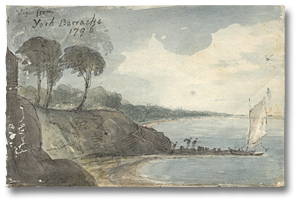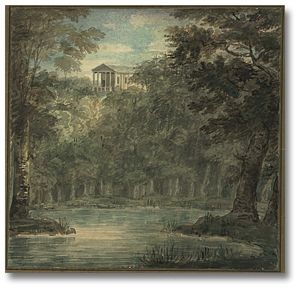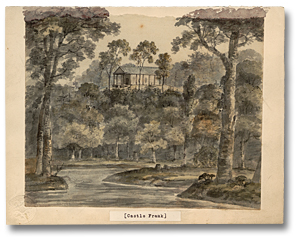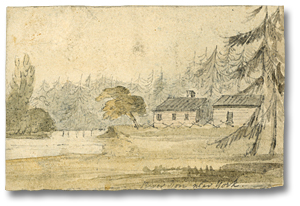
The Trip to York
Arrival in Toronto
In early May 1793, Colonel Simcoe set off for his first brief visit to Toronto, travelling around the head of the lake by boat. He returned a fortnight later:
|
“Coll. Simcoe returned from Toronto & speaks in praise of the harbour, & fine spot near it covered large Oak which he intends to fix upon as a site for a Town.” - May 13th, 1793 |
Then, in early August, Simcoe returned to Toronto accompanied by Elizabeth and the children.
![Drawing: York Harbour [July], [ca. 1796] (detail)](pics/7087-300.jpg)
Click to see a larger version (143K)
York Harbour [July], [ca. 1796], (detail)
Elizabeth Simcoe, (1766-1850)
Pen/paper
Reference Code: F 47-11-1-0-235
Archives of Ontario, I0007087
|
“We rode on the peninsula opposite Toronto, so I called it the spit of land, for it is united to the mainland by a very narrow neck of ground. We crossed the bay opposite the camp, and rode by the lake side to the end of the peninsula. We met with some good natural meadows and several ponds. The trees are mostly of the poplar kind, covered with wild vines, and there are some fir. On the ground were everlasting peas creeping in abundance, of a purple colour. I am told they are good to eat when boiled, and some pretty, white flowers like lilies of the valley. We continued our ride beyond the peninsula on the sands of the north shore of Lake Ontario till we were impeded by large trees on the beach... - August 4th, 1793 |
On the 23rd of August, a proclamation was published, officially renaming the town "York" in honour of the Duke of York who had recently saved Holland from invasion by the French. The name Toronto would be restored in 1834.
|
“I liked it very much, being without the noise of Oars is a great gratification... a man usually paddles at one end of it & a woman at the other but in smooth water little exertion is wanting & they sit quietly as if to take the air the Canoe appears to move as if by clock work - I always wish to conduct a Canoe myself when I see them manage it with such dexterity & grace. A European usually looks awkward & in a bustle compared with the Indian's quiet skill in a canoe.” - September 14, 1793 |

Click to see a larger version (144K)
View From York Barracks, 1796, (detail)
Elizabeth Simcoe, (1766-1850)
Watercolour
Reference Code: F 47-11-1-0-236
Archives of Ontario, I0006353
Castle Frank
At first, the family slept in a "canvas house" -- one of three or four large tents that Simcoe had bought in London at the sale of the effects of Captain Cook, the explorer. Eventually, the Simcoes would build, not at the Scarborough Heights, but a couple of miles up the Don River.
|
“The Governor having determined to take a Lot of 200 acres upon the River Donn for Francis, & the Law obliges persons having Lots of land to build a House upon them within the year we went today to fix upon the spot for building his House.” - September 29th, 1793 |

Click to see a larger version (170K)
Castle Frank, 1796, (detail)
Elizabeth Simcoe, (1766-1850)
Watercolour paper, full
Reference Code: F 47-11-1-0-231
Archives of Ontario, I0006538
In the spring of 1794, construction began on Castle Frank, the Simcoe summer residence. It stood on a steep hill overlooking the Don Valley and was named after the Simcoes' then five-year-old son Francis who was to inherit the residence. The house was still under construction when they returned to England in 1796. Castle Frank would burn down in 1829.
|
“...we walked on the Ice to the House which is building on Francis' 200 acre Lot of Land. It is called Castle Frank built on the plan of a Grecian Temple...” - January 23rd, 1796 |

Click to see a larger version (203K)
Castle Frank, 1796, (detail)
Elizabeth Simcoe, (1766-1850)
Watercolour paper, full
Reference Code: F 47-11-1-0-228
Archives of Ontario, I0006352
River Don
While Simcoe was engaged directing the laying out of the town plot of York, Elizabeth busied herself by exploring the area and visiting neighbours such as John Scadding, the former manager of the Wolford Estate, who had emigrated to Canada in 1792.
He lived just over the Don River at the Queen Street Crossing (later the site of the Toronto Jail). Elizabeth did a watercolour of Scadding's in the autumn of 1793. Shortly after that it was destroyed by fire.

Click to see a larger version (153K)
River Don near York and John Scadding's Cabin,
Autumn, 1793 (detail)
Elizabeth Simcoe, (1766-1850)
pen/paper
Reference Code: F 47-11-1-0-107
Archives of Ontario, I0006959
|
“I rode on the peninsula. My horse has spirit enough to wish to get their before others. I rode a race with Mr. Talbot to keep myself warm. I gathered wild grapes. They were pleasant but not sweet. - Tuesday Sept 23, 1793 |
|
“We went 6 miles by water & landed, climbed up an exceedingly steep hill or rather a series of sugerloafed Hills & approved of the highest spot from whence we looked down on the tops of Large Trees & seeing Eagles near I suppose they build there.” - September 29th, 1793 |
![Watercolour: Lake Ontario shore, [ca. 1793] (detail)](pics/6958-300.jpg)
Click to see a larger version (136K)
Lake Ontario shore, [ca. 1793], (detail)
Elizabeth Simcoe, (1766-1850)
pen/paper
Reference Code: F 47-11-1-0-106
Archives of Ontario, I0006958
|
“...we walked on the Ice to the House which is building on Francis' 200 acre Lot of Land. It is called Castle Frank built on the plan of a Grecian Temple...” - January 23rd, 1796 |
|
“The weather damp, mild and dirty. When will the end of March arrive? I am quite impatient to set out for Detroit.&” - February 9th, 1794 |
![Watercolour: Playter's bridge near York, June 6th, [ca. 1796] (detail)](pics/7085-300.jpg)
Click to see a larger version (182K)
Playter's bridge near York, June 6th, [ca. 1796], (detail)
Elizabeth Simcoe, (1766-1850)
pen/paper
Reference Code: F 47-11-1-0-233
Archives of Ontario, I0007085
In the end, Simcoe would travel to Detroit without Elizabeth. She remained in York where, in mid-April, with both Simcoe and the family doctor absent in the west, Katherine, her youngest daughter died.
In May 1794, Elizabeth returned to Niagara where Governor Simcoe had re-established himself in Navy Hall.
Elizabeth Simcoe - The Early Years | Sailing for the Canadas | Winter in Quebec City
Kingston and the Thousand Islands | Navy Hall and Niagara Falls | Travels Around the Niagara Peninsula
The Trip to York | Return to Niagara | Return to Quebec | The Final Year
Going Home to England | The Simcoe Collection | About Elizabeth's Diaries | John Graves Simcoe
Significant Events in the Early History of Canada | Acknowledgements and Sources